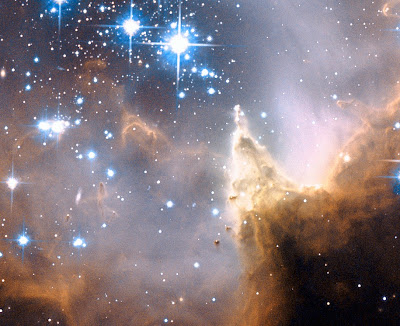Today's APOD is informative, and it is very colorful and fun to look at.
To me, the blue-star fanatic, there is an even bigger story to be told about M101, a story that I don't think is being very clearly revealed in today's APOD. It is that M101 is unique in the nearby universe in that it is
so big
and so blue.
Over time, galaxies in the universe will become ever yellower. First of all, much of the gas supply of the universe is continually being turned into stars, so that there is less and less "raw material" available for the universe to make hot massive blue stars in the first place.
Second, every time the universe makes massive blue stars, it makes a larger number of less massive and non-blue stars at the same. This false-color Hubble image of a star formation region in the Small Magellanic Cloud clearly shows that the large, hot, newborn blue stars are surrounded by a "retinue" of smaller stars. These smaller stars are non-blue, although you can't see that in this picture.
Third, the hot, bright, blue, massive and luminous stars will "burn out" and die quite quickly, while the smaller, less blue stars will hang on. In fact, the smaller and redder a star is, the longer it will live! So over time, more and more yellow and red stars will be created, and these stars will simply not go away.
This SDSS image of galaxy M90 demonstrates what time can do to spiral galaxies. M90 has a bright yellow bulge and large "intermediate" arms without dust lanes and without star formation. M90 has already converted almost all its available star forming material into stars, and now its stars are aging. This means that the blue stars are dying, but the yellow ones are hanging on. M90 is gradually becoming more and more yellow.
Practically all large galaxies in the nearby universe have large yellow populations of stars. This means that even those large spiral galaxies that form a lot of young blue stars, such as
M99, nevertheless have their blue color "diluted" by the massive underlying population of old yellow and red stars. The B-V color index, which compares the light from blue stars with the light from yellow stars, is +0.57 for M99. That is really blue for a large galaxy.
But for M101, the B-V index is as low and as blue as +0.45. To my knowledge, that is absolutely unique for a large galaxy. It is absolutely remarkable.
Why is the color index of M101 so blue? It has to mean that the underlying yellow population is comparatively faint, while the young blue population is absolutely incredibly widespread and bright. In my opinion, M101 must have undergone a fantastic, massive, global star formation event quite recently. Before that, the galaxy must have been rather "quiet", yellow, faint and small. It must have been surrounded by a lot of gas just waiting for a reason to turn itself into stars.
What set off the fantastic star formation? Well, if you check out
this image by Fabian Neyer, you can see a small bluish galaxy, NGC 5474, to the left of large M101. Look more closely at NGC 5474, and you can see that it appears to have a central bulge with a thick "arc" to the left of it! The bulge of the galaxy is displaced relative to the galaxy's disk!
I believe that NGC 5474 has a lot to do with all the action in M101. I believe that these two galaxies are interacting, and this interaction has "sloshed the gas of M101 around" and created incredibly widespread star formation. As you can see from Fabian Neyer's image, an even smaller but also more nearby galaxy, NGC 5477 (a small blue galaxy above M101 in Fabian Neyer's image) is also a part of the action. You can see that the spiral arms of M101 appear to "reach out" for NGC 5477, as if the arms wanted to embrace this small galaxy.
In any case, brilliantly blue and star-sparkling M101 is a unique galaxy in the nearby universe.
Ann
 21st Century M101
21st Century M101


